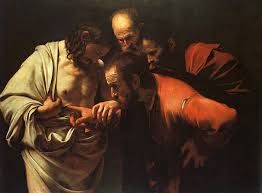Jesus Appears to Thomas
John 20:26-31 and First Corinthians 15:5
A week later
Jesus appears to Thomas DIG:How does Jesus deal with Thomas’ doubt? What is significant about the way Thomas responds? What was Yochanan’s purpose for writing his gospel?
REFLECT: With what doubts or questions about ADONAI are you struggling? What have you found helpful in dealing with your doubts? What has convinced you that Messiah is who He says He is?
After eight days His talmidim were still in Jerusalem. They were in the Upper Room at Mark’s house again, but this time Thomas with them. Though the doors were locked, Jesus came and stood among them and said: Shalom aleikhem – peace be with you (John 20:26; First Corinthians 15:5)! This was the sixth appearance of Jesus after His resurrection.

Then He immediately gave attention to the neediest man in the room. I am comforted by the Lord’s gentle approach. While belief was the issue to be addressed with Thomas, Yeshua knew the apostle’s trouble to be hopelessness, not an obstinate unwillingness to believe. Although Thomas had said previously: Unless I see the nail marks in His hands and put my finger where the nails were, and put my hand into His side, I will not believe (John 20:25); the Great Physician offered Thomas the reassurance he wanted, saying: Put your finger here and look at My [wrists]. Reach out your hand and put it into My side. Stop doubting and believe (John 20:27). It was as if Messiah was saying, “It’s okay to place complete confidence in Me; I won’t let you down. I AM here . . . I AM real . . . and I won’t abandon you.”1679
Thomas didn’t need to touch the Lord’s wounds. But said to Him, “My Lord and my God” (John 20:28)! Thomas announced that Yeshua, the Prince of Life, is God revealed in the flesh. The Jehovah’s Witnesses, however, do not believe in the Trinity or Jesus being God. They pride themselves on worshiping the God of the apostles. But when you ask them about John 20:28 the Jehovah’s Witnesses try to explain away Jesus being called God, by saying that Thomas looked at Jesus and said: My Lord, and then looked up to heaven and said: My God. The text says nothing of the kind, nor is there any evidence anywhere in the world that confirms this view. How would they know? They paint themselves into a theological corner with this ridiculous explanation. Thomas was obviously calling Jesus . . . My God (to see link click Kr – The Holy Spirit Will Teach You All Things, for more on Jehovah’s Witnesses).
Charlotte Elliott wrote the hymn “Just As I Am” in 1834. She had been an invalid for many years, and though she wanted to help with a fund-raiser for a girl’s school, she was too ill. She felt useless, and this inner distress caused her to begin doubting her faith in Christ. She wrote “Just as I am” as a response to her doubt. The crux of her distress is perhaps expressed in her words:
Just as I am, though tossed about With many a conflict, many a doubt,
Fightings and fears within, without, O Lamb of God, I come.
A week after His resurrection, Jesus invited the talmid whom history has nicknamed “Doubting Thomas” to examine the marks of His crucifixion (Jn 20:27). When Thomas touched Yeshua’s wounds, he finally believed in the resurrection. Then Jesus told Him: Because you have seen Me, you have believed; blessed are those who have not seen and yet have believed (Jn 20:29). As believers today, we are the ones who have not seen but still believe. But at times our earthly circumstances create serious questions in our souls. Even then, we cry out: Lord, I believe; help my unbelief (Mk 9:24). Jesus welcomes us to come to Him just as we are.1680
John illustrated four different kinds of faith responses to the resurrection of Yeshua Messiah: Peter and John (20:1-10); Mary Magdalene (20:11-18); the talmidim (20:19-23); and Thomas (20:24-29). In each encounter, they considered the evidence and then chose whether to believe. With each encounter, the tension between tangible evidence and belief increased as each person required more proof than the last. Finally, the Lord blessed all those who believe without the benefit of tangible proof in John 20:29. And with that, Yochanan turns to us, the reader.1681
Jesus performed many other signs in the presence of His apostles, which are not recorded in this book. But these are written that you may continue to believe that Jesus is the Messiah, the Son of God, and that by believing you may have life in His name (John 20:30-31).



Leave A Comment